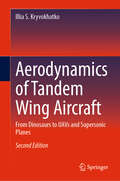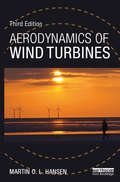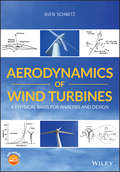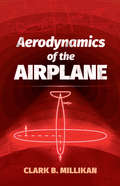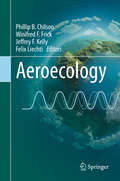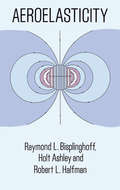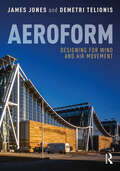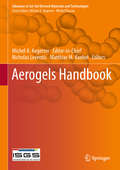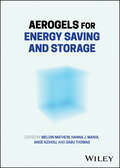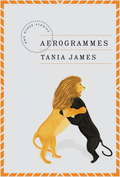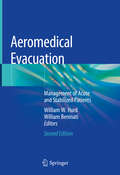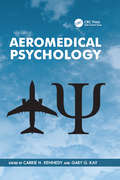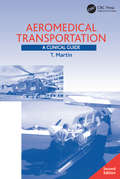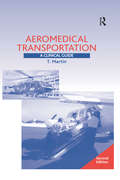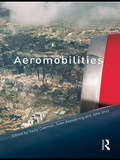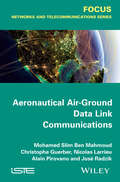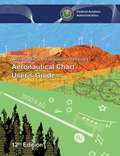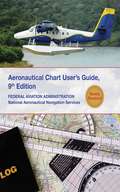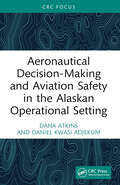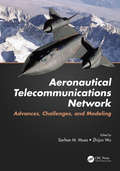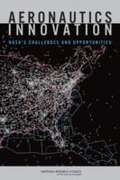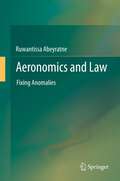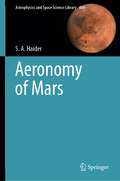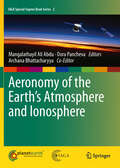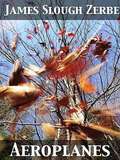- Table View
- List View
Aerodynamics of Tandem Wing Aircraft: From Dinosaurs to UAVs and Supersonic Planes
by Illia S. KryvokhatkoThis updated, second edition adds more reviews of modern four-winged aircraft belonging to convertiplanes, Medium Altitude Long Endurance UAVs, and solar planes. As in the first edition, different analytical, numerical, and experimental methods are discussed in detail. The book presents new sections on unsteady aerodynamic characteristics of tandem wings and specifics of their aerodynamic loading for stress analysis and structural design. Also, dependencies between key geometric parameters and aerodynamic characteristics were updated with new studies that helped to understand the physics more deeply and even reinterpret previous experimental results. Accordingly, practical recommendations in development and optimizing of tandem wing aircraft were updated to provide high endurance, wide range of flight velocities, stability, and controllability. This is an ideal book for graduate students, researchers, and engineers working in fields of aerodynamics and conceptual design of the aircraft especially UAVs and light piloted airplanes.
Aerodynamics of Wind Turbines
by Martin O. HansenAerodynamics of Wind Turbines is the established essential text for the fundamental solutions to efficient wind turbine design. Now in its third edition, it has been substantially updated with respect to structural dynamics and control. The new control chapter now includes details on how to design a classical pitch and torque regulator to control rotational speed and power, while the section on structural dynamics has been extended with a simplified mechanical system explaining the phenomena of forward and backward whirling modes. Readers will also benefit from a new chapter on Vertical Axis Wind Turbines (VAWT). Topics covered include increasing mass flow through the turbine, performance at low and high wind speeds, assessment of the extreme conditions under which the turbine will perform and the theory for calculating the lifetime of the turbine. The classical Blade Element Momentum method is also covered, as are eigenmodes and the dynamic behaviour of a turbine. The book describes the effects of the dynamics and how this can be modelled in an aeroelastic code, which is widely used in the design and verification of modern wind turbines. Furthermore, it examines how to calculate the vibration of the whole construction, as well as the time varying loads and global case studies.
Aerodynamics of Wind Turbines: A Physical Basis for Analysis and Design
by Sven SchmitzA review of the aerodynamics, design and analysis, and optimization of wind turbines, combined with the author’s unique software Aerodynamics of Wind Turbines is a comprehensive introduction to the aerodynamics, scaled design and analysis, and optimization of horizontal-axis wind turbines. The author –a noted expert on the topic – reviews the fundamentals and basic physics of wind turbines operating in the atmospheric boundary layer. He then explores more complex models that help in the aerodynamic analysis and design of turbine models. The text contains unique chapters on blade element momentum theory, airfoil aerodynamics, rotational augmentation, vortex-wake methods, actuator-line modeling, and designing aerodynamically scaled turbines for model-scale experiments. The author clearly demonstrates how effective analysis and design principles can be used in a wide variety of applications and operating conditions. The book integrates the easy-to-use, hands-on XTurb design and analysis software that is available on a companion website for facilitating individual analyses and future studies. This component enhances the learning experience and helps with a deeper and more complete understanding of the subject matter. This important book: Covers aerodynamics, design and analysis and optimization of wind turbines Offers the author’s XTurb design and analysis software that is available on a companion website for individual analyses and future studies Includes unique chapters on blade element momentum theory, airfoil aerodynamics, rotational augmentation, vortex-wake methods, actuator-line modeling, and designing aerodynamically scaled turbines for model-scale experiments Demonstrates how design principles can be applied to a variety of applications and operating conditions Written for senior undergraduate and graduate students in wind energy as well as practicing engineers and scientists, Aerodynamics of Wind Turbines is an authoritative text that offers a guide to the fundamental principles, design and analysis of wind turbines.
Aerodynamics of the Airplane (Dover Books on Aeronautical Engineering)
by Clark B. MillikanWritten on the eve of World War II, this brief but intensive introduction by one of the founders of the Jet Propulsion Laboratory deals with the basic problems of aerodynamics. 1941 edition.
Aeroecology
by Phillip B. Chilson Winifred F. Frick Jeffrey F. Kelly Felix LiechtiThis book consists of a diverse collection of chapters that seeks to broaden our fundamental understanding of the ecological function and biological importance of the Earth’s lower atmosphere, which provides a huge living space for billions of animals moving within and across continents. <P><P>Their migration, dispersal and foraging activities connect water and land habitats within and across continents. Drawing upon the wide-ranging experience of the authors, the book takes an inherently interdisciplinary approach that serves to introduce the reader to the topic of aeroecology, frame some of the basic biological questions that can be addressed within the context of aeroecology, and highlight several existing and emerging technologies that are being used to promote aeroecological studies. The book begins with several background chapters, that provide introduction into such topics as atmospheric science, the concept of the habitat, animal physiology, and methods of navigation. It then continues with a broad discussion of observational methods available to and used by aeroecologists. Finally, several targeted examples of aeroecological studies are presented. <P><P>Following the development of the chapters, the reader is provided with a unifying framework for investigating how the dynamic properties of meteorological conditions at local, regional, and global scales affect the organisms that depend on the air for foraging and movement. Material presented in the book should be of interest to anyone wishing to gain a comprehensive understanding of the aerosphere itself and the myriad airborne organisms that inhabit and depend upon this environment for their existence. The material should be accessible to a diverse set of readers at all stages of training and across a range of research expertise.
Aeroelasticity (Dover Books on Aeronautical Engineering)
by Holt Ashley Robert L. Halfman Raymond L. BisplinghoffDesigned as both a textbook for advanced engineering students and a reference book for practicing engineers, this highly regarded work deals not only with the practical aspects of aeroelasticity, but the aerodynamic and structural tools upon which these rest. Accordingly, the book divides roughly into two halves: the first deals with the tools and the second with applications of the tools to aeroelastic phenomena.Topics include deformation of airplane structures under static and dynamic loads, approximate methods of computing natural mode shapes and frequencies, two-and three-dimensional incompressible flow, compressible flow, wings and bodies in three-dimensional unsteady flow, static aeroelastic phenomena, flutter, dynamic response phenomena, aeroelastic model theory, model design and construction, testing techniques and more. Chapters have been designed to progress from easy to difficult so that instructors using this book as an elementary text in aeroelasticity will find their purposes served by simply using the first parts of selected chapters.Helpful appendixes deal with such mathematical tools as matrices and linear systems (prerequisites include the usual engineering mathematics courses and advanced calculus), while many numerical examples are included throughout the text. Engineering students as well as practicing engineers will find this work an unmatched treatment of the topic and an indispensable reference for their libraries.
Aeroform: Designing for Wind and Air Movement
by James Jones Demetri TelionisAeroform: Designing for Wind and Air Movement provides a comprehensive introduction to applying aerodynamic principles to architectural design. It presents a challenge to architects and architectural engineers to give shape to the wind and express its influence on architectural form. The wind pushes and pulls on our buildings, infiltrates and exfiltrates through cracks and openings, and lifts roofs during storm events. It can also offer opportunities for resource conservation through natural ventilation or a biophilic connection between indoors and out. This book provides basic concepts in fluid mechanics such as materials, forces, equilibrium, pressure, and hydrostatics; introduces the reader to the concept of airflow; and provides strategies for designing for wind resistance, especially in preventing uplift. Natural ventilation and forced airflow are explored using examples such as Thomas Herzog’s Hall 26 in Hanover, RWE Ag building in Essen Germany, and the Kimbell Art Museum in Texas. Finally, issues of wind and airflow measurement are addressed. A reference for students and practitioners of architecture and architectural engineering, this book is richly illustrated and presents complex concepts of aerodynamic engineering in easy-to-understand language. It prepares the architect or architectural engineer to design buildings that are visually expressive of a dialogue between wind and built form.
Aerogels Handbook (Advances in Sol-Gel Derived Materials and Technologies)
by Michel Andre Aegerter Matthias M. Koebel Nicholas LeventisAerogels are the lightest solids known. Up to 1000 times lighter than glass and with a density as low as only four times that of air, they show very high thermal, electrical and acoustic insulation values and hold many entries in Guinness World Records. Originally based on silica, R&D efforts have extended this class of materials to non-silicate inorganic oxides, natural and synthetic organic polymers, carbon, metal and ceramic materials, etc. Composite systems involving polymer-crosslinked aerogels and interpenetrating hybrid networks have been developed and exhibit remarkable mechanical strength and flexibility. Even more exotic aerogels based on clays, chalcogenides, phosphides, quantum dots, and biopolymers such as chitosan are opening new applications for the construction, transportation, energy, defense and healthcare industries. Applications in electronics, chemistry, mechanics, engineering, energy production and storage, sensors, medicine, nanotechnology, military and aerospace, oil and gas recovery, thermal insulation and household uses are being developed with an estimated annual market growth rate of around 70% until 2015. The Aerogels Handbook summarizes state-of-the-art developments and processing of inorganic, organic, and composite aerogels, including the most important methods of synthesis, characterization as well as their typical applications and their possible market impact. Readers will find an exhaustive overview of all aerogel materials known today, their fabrication, upscaling aspects, physical and chemical properties, and most recent advances towards applications and commercial products, some of which are commercially available today. Key Features: *Edited and written by recognized worldwide leaders in the field *Appeals to a broad audience of materials scientists, chemists, and engineers in academic research and industrial R&D *Covers inorganic, organic, and composite aerogels *Describes military, aerospace, building industry, household, environmental, energy, and biomedical applications among others
Aerogels for Energy Saving and Storage
by Sabu Thomas Hanna J. Maria Ange Nzihou Meldin MathewExplore the energy storage applications of a wide variety of aerogels made from different materials In Aerogels for Energy Saving and Storage, an expert team of researchers delivers a one-stop resource covering the state-of-the-art in aerogels for energy applications. The book covers their morphology, properties, and processability and serves as a valuable resource for researchers and professionals working in materials science and environmentally friendly energy and power technology. The authors offer a comprehensive review of highly efficient energy applications of aerogels that bridges the gap between engineering, science, and chemistry and advances the field of materials development. They provide a Life Cycle Assessment of aerogels in energy systems, as well as discussions of their impact on the environment. Aerogel synthesis, characterization, fabrication, morphology, properties, energy-related applications, and simulations are all explored, and likely future research directions are provided. Readers will also find: A thorough introduction to aerogels in energy, including state-of-the-art advancements and challenges newly encountered Comprehensive explorations of chitin-based and cellulose-derived aerogels, as well as lignin-, clay-, and carbon nanotube-based aerogels Practical discussions of organic, natural, and inorganic aerogels, with further analyses of the lifecycle of aerogels In-depth examinations of the theory, modeling, and simulation of aerogels Perfect for chemical and environmental engineers, Aerogels for Energy Saving and Storage will also earn a place in the libraries of chemistry and materials science researchers in academia and industry.
Aerogrammes
by Tania JamesFrom the highly acclaimed author of Atlas of Unknowns ("Dazzling...One of the most exciting debut novels since Zadie Smith's White Teeth" --San Francisco Chronicle),a bravura collection of short stories set in locales as varied as London, Sierra Leone, and the American Midwest that captures the yearning and dislocation of young men and women around the world. In "Light & Luminous," a gifted instructor of Indian dance falls victim to the vanity and insecurities that have followed her into middle age. In "Tonto and the Undertaker," a widower copes with his loss by cruising Kentucky highways and burying roadkill. In "The Scriptological Review" a damaged young man obsessively studies his father's handwriting in hopes of making sense of his suicide. And in "What to Do with Henry," a white woman from Ohio takes in the illegitimate child her husband left behind in Sierra Leone, as well as an orphaned chimpanzee who comes to anchor this strange new family. With Aerogrammes, Tania James once again introduces us to a host of delicate, complicated, and beautifully realized characters who find themselves separated from their friends, families, and communities by race, pride, and grief.This eBook editional includes a Reading Group Guide.
Aeromedical Evacuation: Management of Acute and Stabilized Patients
by William W. Hurd William BeninatiThe definitive treatment on the medical evacuation and management of injured patients in both peace- and wartime. Edited by eminent experts in the field, this text brings together medical specialists from all four branches of the armed services. It discusses the history of aeromedical evacuation, triage and staging of the injured patient, evacuation from site of injury to medical facility, air-frame capabilities, medical capabilities in-flight, response to in-flight emergencies, and mass emergency evacuation. Specific medical conditions are addressed in detail, including such general surgical casualties as abdominal wounds and soft tissue, vascular, maxillofacial, head and spinal cord injuries, ophthalmologic, orthopaedic, pediatric, obstetric-gynecologic casualties, burns, and more. Over 80 illustrations provide a review of transport equipment and both medical and surgical treatment. A must-have reference for all armed forced physicians and flight surgeons, for general and trauma surgeons, internists, intensive care specialists, orthopaedic surgeons, and public health service physicians.
Aeromedical Psychology: Clinical Assessment And Determination Of Flight Status
by Carrie H. Kennedy Gary G. KayAeromedical psychology is that branch of psychology pertaining to the assessment, selection and evaluation of aviation personnel. This book, Aeromedical Psychology, is designed to provide the means for a variety of clinicians to carry out sound assessment and selection procedures, perform informed evaluations and make subsequent recommendations regarding flight status and treatment strategies geared to the aviation environment. To facilitate a dynamic understanding of the field, the book emphasizes an integration of applications and theory, case examples and research. The book is divided into three parts. The first presents assessment and selection procedures for aviation personnel (i.e. air traffic controllers, flight officers and pilots) and astronauts and the many ways in which both psychologists and psychiatrists are involved in these roles. In the second part, the waiver standards put forth by both the FAA and the various branches of the military are presented, as well as the waiver decision process. Clinical issues unique to aviation - notably fear of flying, motivation to fly and airsickness - are addressed, as well as possible courses of intervention, treatment and disposition. In the final part, more specialized issues pertaining to aeromedical psychology are dealt with, namely the psychopharmacological research and regulations applicable to recreational pilots and aviation personnel, managing the aftermath of aviation mishaps and the psychologist's role in accident investigations.
Aeromedical Transportation: A Clinical Guide
by T. MartinStill the only book published anywhere in the world which is devoted entirely to the principles of aeromedical transport, Aeromedical Transportation has rightly become known as the sole reference for the industry. This second edition has been radically revised and updated; featuring the latest research, updated references and new chapters on the transport of intensive care patients, and medical emergencies/death in flight. Since the first edition was published in 1996, the concept of 'evidence-based medicine' has been accepted as essential in any book which endeavours to be the accepted knowledge base in its subject area. A very practical text, international in its approach, much of its content is devoted to clinical matters. Administration and organisation are also discussed, but are addressed from the standpoint of the clinical aeromedical escort. The text is suitable for medical, paramedical and nursing personnel and for those working in organizations whose duties include the transportation of the sick and injured by air.
Aeromedical Transportation: A Clinical Guide
by Terence MartinThis book focuses on the principles of aeromedical transport and includes latest research and new chapters on the transport of intensive care patients and medical emergencies/death in flight. It is intended for medical personnel whose duties include the transportation of the sick and injured by air.
Aeromobilities (International Library of Sociology)
by John Urry Sven Kesselring Saulo CwernerAeromobilities is a collection of essays that tackle in many different ways the growing importance of aviation and air travel in our hypermobile, globalized world. Providing a multidisciplinary focus on issues ranging from global airports to the production of airspace, from airline work to helicopters, and from movement in airports to software systems, Aeromobilities seeks to enhance our understanding of space, time and mobility in the age of mass air travel. From Sao Paulo to Sydney, Aeromobilities draws on local experiences of airspaces to generate theory and research that are global in scope. It is the first book of its kind, bringing together a wide range of theoretical and methodological approaches to aviation and air travel in the social sciences and humanities, while emphasizing the central role of aeromobilities in contemporary social relations. In a world where virtually every aspect of social life is touched upon, in one way or another, by the complex global network of airline flows, with its large passenger aircraft and iconic international airports, Aeromobilities provides innovative analyses of some of the most fundamental and influential mobility networks of our time.
Aeronautical Air-Ground Data Link Communications
by Nicolas Larrieu Mohamed Slim Ben Mahmoud Christophe Guerber José Radzik Alain PirovanoThis book deals with air-ground aeronautical communications. The main goal is to give the reader a survey of the currently deployed, emerging and future communications systems dedicated to digital data communications between the aircraft and the ground, namely the data link. Those communication systems show specific properties relatively to those commonly used for terrestrial communications. In this book, the system architectures are more specifically considered from the access to the application layers as radio and physical functionalities have already been addressed in detail in others books.The first part is an introduction to aeronautical communications, their specific concepts, properties, requirements and terminology. The second part presents the currently used systems for air ground communications in continental and oceanic area. The third part enlightens the reader on the emerging and future communication systems and some leading research projects focused on this scope. Finally, before the conclusion, the fourth part gives several main challenges and research directions currently under investigation.
Aeronautical Chart User's Guide: Aeronav Products (FAA Handbooks Ser.)
by Federal Aviation AdministrationThe updated 11th edition of the Aeronautical Chart User’s Guide by the FAA is a great reference for novice pilots and professionals alike. Printed in full color with detailed examples, this book provides all the information students and pilots need to know about all the symbols and information provided on US aeronautical charts and chart navigation publications. Readers will find information on VFR charts, aeronautical chart symbols, helicopter route charts, flyway planning charts, IFR enroute charts, explanation of IFR enroute terms and symbols, Terminal Procedure Publications (TPPs), explanation of TPP terms and symbols, airspace classifications, and an airspace class table.
Aeronautical Chart Users Guide: National Aeronautical Navigation Services
by Federal Aviation AdministrationA critical reference tool for any aeronautical navigator, the ninth edition of the Aeronautical Chart User's Guide presents the most up-to-date information on charts adhering to Visual Flight Rule (VFR) and Instrument Flying Rule (IFR). Hundreds of color images throughout the book are paired with easy-to-understand explanations and definitions. This concise guide allows pilots and students to successfully pre-plan flight paths through any type of environment from man-made obstacles to natural terrain. In addition, the updated Aeronautical Chart User's Guide is a great study aid for current pilots who are preparing for additional certification and for potential pilots who are interested in applying for their first license.
Aeronautical Decision-Making and Aviation Safety in the Alaskan Operational Setting
by Daniel Kwasi Adjekum Dana AtkinsAeronautical Decision-Making and Aviation Safety in the Alaskan Operational Setting introduces the reader to the real-life experiences of aviators who fly in remote settings such as Alaska in the United States. It covers the challenges related to limited aviation infrastructure and support that affect human factors like aeronautical decision-making and its impact on aviation safety.Through a unique blend of meticulous case study analysis and semi-structured interviews with Alaskan pilots, this book offers a comprehensive understanding of the proverbial challenges of flying in Alaska. It uncovers the human factors elements specific to this environment, shedding light on the factors that influence a pilot’s decision-making, which may contribute to the high rate of accidents in Alaska and other remote regions. The content is supported by historical and socioeconomic perspectives on remote-setting aviation operations. Global perspectives are discussed with narratives from one author’s experiences flying to remote airstrips in Africa. The book concludes with practical recommendations to improve decision-making and aviation safety in these remote settings, making it a must-read for aviation professionals.This insightful research is not just for academic consumption. It is a practical guide for aviation professionals, including pilots, dispatch teams, air traffic controllers, and aviation support personnel. It offers valuable insights into the human factors involved in flying in Alaska, which can be directly applied in other aviation resource-constrained geographical regions, making it an indispensable resource for those in the field.
Aeronautical Telecommunications Network: Advances, Challenges, and Modeling
by Sarhan M. Musa Zhijun WuAddresses the Challenges of Modern-Day Air TrafficAir traffic control (ATC) directs aircraft in the sky and on the ground to safety, while the Aeronautical Telecommunications Network (ATN) comprises all systems and phases that assist in aircraft departure and landing. The Aeronautical Telecommunications Network: Advances, Challenges, and Mod
Aeronautics Innovation: Nasa's Challenges And Opportunities
by National Research Council of the National AcademiesNASA is a global leader in aeronautics research and development — fostering advances in aviation safety and emissions, propulsion technology, and many other areas. And the agency's Aeronautics Research Mission Directorate (ARMD) has played a vital role in the U.S. aeronautics industry. In recent years, the directorate's leaders and experts outside the agency have sought ways to speed innovative uses of ARMD's research results. But the directorate faces management challenges that make it difficult for such applications to succeed — or to occur at all. This report from the National Academies' National Research Council, offers the agency guidance on how to manage the transfer of technology to external users, as well as implement flexible personnel and financial-management practices. The report also points out problems that stem from a lack of agreement on ARMD's future direction and several years of federal budget cuts.
Aeronomics and Law: Fixing Anomalies
by Ruwantissa AbeyratneThis book embarks on a contemporary analysis of the interaction of economics and law relating to air transport, delving into the major issues that plague the industry. It shows how some of the thorny and frustrating issues could be approached sensibly. Among the issues discussed are the anomaly of exponential growth of air transport which makes airline profitability continue to be poor; the legislative impediments in most countries that preclude direct foreign investment in the industry; the confounding and muddled mess behind the economics of aircraft engine emissions; and the inexplicable reality that, although civil aviation is primarily meant to meet the needs of the people of the world, State regulators have upended the equation and given priority to national interests over the interests of the passenger. The book will be of interest to economists and lawyers alike who deal with air transport issues, and also to academics and students in the area of transportation as well as regulators and airlines.
Aeronomy of Mars (Astrophysics and Space Science Library #469)
by S. A. Haider“Mangalyaan was launched on November 5, 2013, to Mars by Indian Space Research Organization (ISRO). On October 2, 2022, ISRO declared that Mangalyaan had lost communications with Earth. Mars Color Camera (MCC) on-board Mangalyaan has taken thousands pictures of Mars. A full disk of Mars image observed by Viking is shown on the cover page of this book. Mars is covered by the dust as observed by Mangalyaan (from Arya et al., 2015). This book presents the atmospheric and ionospheric results obtained from all missions to Mars. It also covers various atmospheric and ionospheric models of Mars. Broadly speaking, the planet’s atmosphere can be divided into two regions: lower and upper. These two regions can be coupled due to the propagation of energy from the lower to the upper atmosphere. The first-ever book on the aeronomy of Mars, this work is intended to help students and researchers familiarize themselves with the field of aeronomy. In addition, it helps planetary probe designers, engineers, and other users in the scientific community, e.g., planetary geologists and geophysicists”.
Aeronomy of the Earth's Atmosphere and Ionosphere (IAGA Special Sopron Book Series #2)
by Archana Bhattacharyya Dora Pancheva Mangalathayil Ali AbduThis book is a multi-author treatise on the most outstanding research problems in the field of the aeronomy of the Earth's atmosphere and ionosphere, encompassing the science covered by Division II of the International Association of Geomagnetism and Aeronomy (IAGA). It contains several review articles and detailed papers by leading scientists in the field. The book is organized in five parts: 1) Mesosphere-Lower Thermosphere Dynamics and Chemistry; 2) Vertical Coupling by Upward Propagating Waves; 3) Ionospheric Electrodynamics and Structuring; 4) Thermosphere- Ionosphere Coupling, Dynamics and Trends and 5) Ionosphere-Thermosphere Disturbances and Modeling. The book consolidates the progress achieved in the field in recent years and it serves as a useful reference for graduate students as well as experienced researchers.
Aeroplanes
by James Slough Zerbe"Aeroplanes" by James Slough Zerbe is a comprehensive guide focusing on the theories and practical application of flying machines. The book explores topics such as the principles of aeroplane flight, different methods of controlling flying machines, the history of kites and gliders, propeller design, and the role of aeroplanes in war. It provides detailed explanations on aeroplane construction, power application, and the technical aspects of propeller design. With a blend of technical terminology and practical insights, the book offers a thorough overview of the principles and technologies involved in the development and operation of flying machines.
